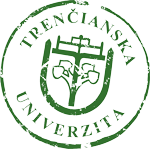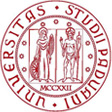Articles published by FunGlass researchers
We would like to draw your attention to the new papers of our researchers presenting their research results achieved in collaboration with the colleagues from FunGlass partners´ institutions. The papers are published in peer-reviewed and highly cited journals:
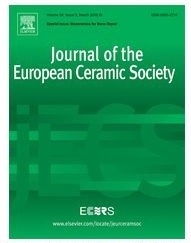 Katarina Drdlikova, Daniel Drdlik, Hynek Hadraba, Robert Klement, Karel Maca: Optical and mechanical properties of mn-doped transparent alumina and their comparison with selected rare earth and transient metal doped aluminas. In: Journal of the European Ceramic Society, Volume 40, Issue 14, 2020, Pages 4894-4900.
Katarina Drdlikova, Daniel Drdlik, Hynek Hadraba, Robert Klement, Karel Maca: Optical and mechanical properties of mn-doped transparent alumina and their comparison with selected rare earth and transient metal doped aluminas. In: Journal of the European Ceramic Society, Volume 40, Issue 14, 2020, Pages 4894-4900.
https://doi.org/10.1016/j.jeurceramsoc.2020.01.041
Abstract: Mn-doped translucent alumina prepared in this work was characterised in terms of densification process, microstructure, optical and mechanical properties. The manganese effect was compared with the influence of chromium, erbium and europium in previously prepared doped transparent alumina. Contrary to them, manganese accelerates both densification and grain growth. Real in line transmittance (RIT) at 632.8 nm and transmission/diffuse reflectance spectra in UV-VIS-NIR range of Mn-doped alumina were measured. The lower RIT values and rapidly decreased transmittance/reflectance below 800 nm are caused by relatively high absorption of light by Mn species and by increased grain size. The deep red emission of Mn4+ centres that almost fade at higher manganese concentration was indicated in photoluminescence spectra, with a decay time of ∼670 μs. The dopant introduction in all cases resulted in an increase in hardness of doped alumina up to 20 % compared to undoped alumina and a decrease in related fracture toughness.
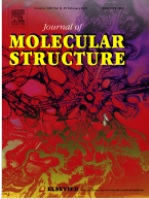 Shiju, D. Arish, S. Kumaresan: Novel water soluble Schiff base metal complexes: Synthesis, characterization, antimicrobial-, DNA cleavage, and anticancer activity. In: Journal of Molecular Structure, Volume 1221, 2020.
Shiju, D. Arish, S. Kumaresan: Novel water soluble Schiff base metal complexes: Synthesis, characterization, antimicrobial-, DNA cleavage, and anticancer activity. In: Journal of Molecular Structure, Volume 1221, 2020.
https://doi.org/10.1016/j.molstruc.2020.128770
Abstract: The Schiff base ligand, 4-nitrobenzaldehyde-glycylglycine (4-NBA-GG) and its Co(II), Ni(II), Cu(II), and Zn(II) complexes were synthesized and characterized by elemental analysis, mass, NMR, IR, electronic spectra, magnetic moment, molar conductance, ESR, CV, TGA, and powder XRD. All the complexes were found to be soluble in water. According to the spectral analysis, the 4-NBA-GG acts as a tridentate monobasic donor coordinating through the azomethine nitrogen, carboxylato oxygen and deprotonated peptide nitrogen atoms. The geometrical structures of these complexes are found to be octahedral. Antimicrobial studies of the synthesized compounds were evaluated and reported. The DNA cleavage activities were assayed against E. coli DNA, besides, anticancer activities was also studied towards human Colon Cancer Cells (HCT116) and cervical cancer cell line (HeLa). The obtained results showed that the complexes, especially Cu(II) and Zn(II) complexes strongly interact with E. coli DNA and active against both cancer cells.
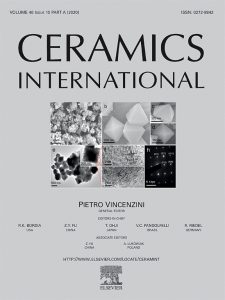 Hamada Elsayed, Martiniano Picicco, Arish Dasan, Jozef Kraxner, Dusan Galusek, Enrico Bernardo: Glass powders and reactive silicone binder: Application to digital light processing of bioactive glass-ceramic scaffolds. In: Ceramics International, Volume 46, Issue 16, Part A, 2020, Pages 25299-25305.
Hamada Elsayed, Martiniano Picicco, Arish Dasan, Jozef Kraxner, Dusan Galusek, Enrico Bernardo: Glass powders and reactive silicone binder: Application to digital light processing of bioactive glass-ceramic scaffolds. In: Ceramics International, Volume 46, Issue 16, Part A, 2020, Pages 25299-25305.
https://doi.org/10.1016/j.ceramint.2020.06.323
Abstract: Powdered ‘silica-defective glasses’, mixed with silicones, have been already shown as a promising solution for the sintering, in air, of glass-ceramics with complex geometries. A fundamental advantage of the approach is the fact silicones act as binders up to the firing temperature, at which they transform into silica. A specified ‘target’ glass-ceramic formulation is achieved through the interaction between glass powders and the binder-derived silica. The present paper is dedicated to the extension of the approach to the digital light processing of reticulated glass-ceramic scaffolds, for tissue engineering applications, starting from glass powders suspended in an engineered photocurable silicone-based binder. The silicone component, besides providing an extended binding action up to the maximum firing temperature, stabilizes the 3D-printed shapes during sintering. The formation of a rigid silica skeleton, from the transformation of the silicone binder, prevents from excessive viscous flow of softened glass. The final phase assemblage does not depend simply on glass devitrification but also on the glass/silica skeleton interaction.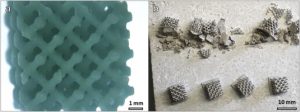
 Kozłowski, M., Khater, G., Olesik, P. & M. Mahmoud: Preparation and characterization of lightweight glass–ceramics based on industrial wastes. In: Journal of the Australian Ceramic Society volume 56, pages11–20(2020).
Kozłowski, M., Khater, G., Olesik, P. & M. Mahmoud: Preparation and characterization of lightweight glass–ceramics based on industrial wastes. In: Journal of the Australian Ceramic Society volume 56, pages11–20(2020).
https://doi.org/10.1007/s41779-019-00438-z
Abstract: Lightweight glass–ceramics based on bypass cement dust and glass waste were prepared successfully through a powder technology method. Five batches with 20 to 50% cement bypass (with regard to the glass waste) were mixed and compressed by uniaxial dry pressing into discs then applied into direct sintering at 1000 °C for 1 h. To investigate the properties of the obtained glass-ceramics, different methods were applied, including DSC, XRD, SEM, investigation of thermal expansion coefficient, bending strength and microhardness. XRD showed that the major crystalline phase is wollastonite. SEM showed that open and closed pores increased gradually until reaching its optimum value for sample 35 bp (35% bypass + 65% glass waste). The density and porosity range for the obtained glass-ceramics were 1.3–2.0 g/cm3 and 31–56%, respectively.
![]() Talimian, A.; Pouchly, V.; Maca, K.; Galusek, D.: Densification of Magnesium Aluminate Spinel Using Manganese and Cobalt Fluoride as Sintering Aids. In: Materials 2020, 13, 102.
Talimian, A.; Pouchly, V.; Maca, K.; Galusek, D.: Densification of Magnesium Aluminate Spinel Using Manganese and Cobalt Fluoride as Sintering Aids. In: Materials 2020, 13, 102.
https://doi.org/10.3390/ma13010102
Abstract: Highly dense magnesium aluminate spinel bodies are usually fabricated using pressure-assisted methods, such as spark plasma sintering (SPS), in the presence of lithium fluoride as a sintering aid. The present work investigates whether the addition of transition metal fluorides promotes the sintering of MgAl2O4 bodies during SPS. At the same time, such fluorides can act as a source of optically active dopants. A commercial MgAl2O4 was mixed with 0.5 wt% of LiF, MnF2, and CoF2 and, afterwards, consolidated using SPS at 1400 °C. Although MnF2 and CoF2 promote the densification as effectively as LiF, they cause significant grain growth.
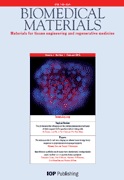 Schuhladen, P. Mukoo, L. Liverani, Z. Neščáková, A. Boccaccini: Manuka honey and bioactive glass impart methylcellulose foams with antibacterial effects for wound-healing applications. In: Biomedical Materials. 2020, vol. 15, no 6.
Schuhladen, P. Mukoo, L. Liverani, Z. Neščáková, A. Boccaccini: Manuka honey and bioactive glass impart methylcellulose foams with antibacterial effects for wound-healing applications. In: Biomedical Materials. 2020, vol. 15, no 6.
https://iopscience.iop.org/article/10.1088/1748-605X/ab87e5
Abstract: Wound dressings able to deliver topically bioactive molecules represent a new generation of 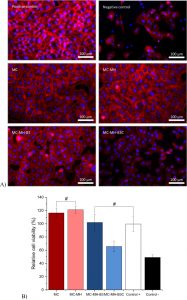 wound-regeneration therapies. In this article, foams based on methylcellulose cross-linked with Manuka honey were used as a platform to deliver borate bioactive glass particles doped additionally with copper. Borate bioactive glasses are of great interest in wound-healing applications due to a combination of favorable features, such as angiogenic and antibacterial properties. The multifunctional composite providing the dual effect of the bioactive glass and Manuka honey was produced by freeze-drying, and the resulting foams exhibit suitable morphology characterized by high porosity. Moreover, the performed tests showed improved wettability and mechanical performance with the addition of bioactive glass particles. Dissolution studies using simulated body fluid and cell biology tests using relevant skin cells further proved the excellent bioactivity and positive effects of the foams on cell proliferation and migration. Most interestingly, by the dual release of Manuka honey and ions from the copper-doped bioactive glass, an antibacterial effect against E. coli and S. aureus was achieved. Therefore, the multifunctional foams showed promising outcomes as potential wound dressings for the treatment of infected wounds.
wound-regeneration therapies. In this article, foams based on methylcellulose cross-linked with Manuka honey were used as a platform to deliver borate bioactive glass particles doped additionally with copper. Borate bioactive glasses are of great interest in wound-healing applications due to a combination of favorable features, such as angiogenic and antibacterial properties. The multifunctional composite providing the dual effect of the bioactive glass and Manuka honey was produced by freeze-drying, and the resulting foams exhibit suitable morphology characterized by high porosity. Moreover, the performed tests showed improved wettability and mechanical performance with the addition of bioactive glass particles. Dissolution studies using simulated body fluid and cell biology tests using relevant skin cells further proved the excellent bioactivity and positive effects of the foams on cell proliferation and migration. Most interestingly, by the dual release of Manuka honey and ions from the copper-doped bioactive glass, an antibacterial effect against E. coli and S. aureus was achieved. Therefore, the multifunctional foams showed promising outcomes as potential wound dressings for the treatment of infected wounds.
![]() Hujova, M.; Rabelo Monich, P.; Sedlacek, J.; Hnatko, M.; Kraxner, J.; Galusek, D.; Bernardo, E.: Glass-Ceramic Foams from Alkali-Activated Vitrified Bottom Ash and Waste Glasses. In Applied Scinces. 2020, 10, 5714.
Hujova, M.; Rabelo Monich, P.; Sedlacek, J.; Hnatko, M.; Kraxner, J.; Galusek, D.; Bernardo, E.: Glass-Ceramic Foams from Alkali-Activated Vitrified Bottom Ash and Waste Glasses. In Applied Scinces. 2020, 10, 5714.
https://doi.org/10.3390/app10165714
Abstract: Both vitrified bottom ashes (VBAs) and waste glasses are forms of inorganic waste material that are widely landfilled, despite having some economic potential. Building on previous studies, we prepared glass-ceramic foams by the combination of VBA with either soda-lime glass (SLG) or borosilicate glass (BSG). Suspensions of fine powders in weakly alkaline solution underwent gelation, followed by frothing at nearly room temperature. Hardened “green” foams were sintered, with concurrent crystallization, at 850–1000 °C. All foams were highly porous (>70%), with mostly open porosity. The glass addition was fundamental in both gelation (promoting the formation of carbonate and silicate hydrated phases) and firing steps. While SLG addition enhanced the viscous flow sintering, without a significant impact on the crystallization of gehlenite, the main crystalline phase from the devitrification of VBA, BSG addition caused a reactive sintering, with remarkable changes in the phase assemblage. The glass addition generally also allowed lower sintering temperatures and yielded products with excellent crushing strength. However, only specific conditions resulted in the complete immobilization of pollutants (e.g., Cr3+ ions).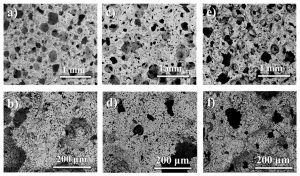
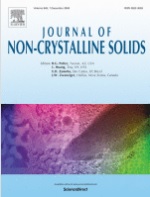 Roman Svoboda, Maria Chromčíková, Branislav Hruška, Marek Liška: Correlation between the activation energies of structural relaxation and viscous flow for BaO–P2O5–Al2O3 glasses. In: Journal of Non-Crystalline Solids, Volume 536, 2020, 119998.
Roman Svoboda, Maria Chromčíková, Branislav Hruška, Marek Liška: Correlation between the activation energies of structural relaxation and viscous flow for BaO–P2O5–Al2O3 glasses. In: Journal of Non-Crystalline Solids, Volume 536, 2020, 119998.
https://doi.org/10.1016/j.jnoncrysol.2020.119998
Abstract: Viscosity and structural relaxation were studied by thermomechanical analysis for six Al2O3-doped BaO–P2O5 glasses. The low-temperature viscosity data (107– 1011 Pa•s) were described and modeled by the Vogel-Fulcher-Tammann, Avramov-Milchev and Mauro-Yue-Ellison-Gupta-Allan equations. Temperature dependence of the activation energy of viscous flow was determined from the tangent of the extrapolated (in terms of the three viscosity equations) viscosity-temperature data-curves. Values of the activation energy of viscous flow were compared to the activation energies of volume relaxation determined from the exact physico-chemical description of the cyclic thermomechanical measurements performed over the glass transition region. In addition, differential scanning calorimetry was used to determine the activation energies of enthalpy relaxation. Good correspondence between the relaxation and viscosity activation energies was found in the respective temperature ranges. Good agreement was also confirmed for the viscosity and enthalpy fragilities, as well as for the indicator of the thermodynamic fragility.







